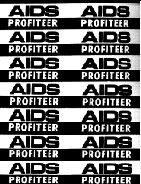February 11, 1989: Soup Kitchen rally at Grand Army Plaza in front of Trump Plaza. A coalition of groups protest the city's failure to respond to homelessness in the face of the tax breaks given to Donald Trump.
March 2, 1989: Protests and continued pressure at the FDA pay off. The FDA approves the use of DHPG, the only drug available to treat cytomegalovirus, which can cause retinitis, pneumonia and colitis.
March 28, 1989: ACT UP's second anniversary protest draws 3,000 to New York's City Hall, making "Target City Hall" the largest AIDS activist demonstration to date. ACT UP protests the inadequacy of New York's AIDS policy under Mayor Edward Koch. About 200 are arrested.

April 21, 1989: ACT UP/NY joins ACT UP/Atlanta to protest a South Carolina provision that would allow PWAs to be quarantined. The same day, using steel plates and rivets, four ACT UP members barricade themselves into a Burroughs Wellcome office in North Carolina. They demand a cut in the price of AZT, still the most expensive medicine in history at $8,000 for a year's dosage.
May 2, 1989: Based on the testimony of AIDS activists, the FDA Advisory Committee finally recognizes DHPG and Aerosolized Pentamadine for approval.
June 4-9, 1989: ACT UP demonstrates at the Fifth International Conference on AIDS in Montreal calling for a significant change in AIDS treatment research. ACT UP presents the revolutionary concept of parallel track drug testing, in which drugs already found to be non-toxic are placed in both clinical trials and released simultaneously to patients who do not qualify for the trials.
The next week, ACT UP members are invited to discuss parallel track with Dr. Anthony Fauci, Director of the AIDS program at the National Institute of Allergy and Infectious Diseases. Days later, Fauci announces parallel track publicly, and the government appoints a panel (including an ACT UP member) to write procedural standards.
That same week, ACT UP meets with Bristol Myers, the manufacturer of the anti-retroviral ddI, to demand ddI's release to patients who can no longer tolerate AZT. DdI is soon released to 5,000 patients.
September 14, 1989: ACT UP once again makes history by stopping trading on the Stock Exchange floor. Seven ACT UP members infiltrate the New York Stock Exchange and chain themselves to the VIP balcony. Their miniature foghorns drown out the opening bell, and a banner unfurls above the trading floor demanding "SELL WELLCOME." Other ACT UP members snap photos which they then sneak out and send over newswires. Four days later, Burroughs Wellcome lowers the price of AZT by 20%, to $6,400 per year.
September 16, 1989: ACT UP NY joins ACT UP Long Island in a demonstration protesting the lack of AIDS housing on Long Island including a march to the home of NY Senator Marino.
October 2, 1989: In response to the alarming rise of HIV infection in adolescents, ACT UP's Youth Brigade (later known as YELL-Youth Education Life Line) begins distributing condoms and safer sex/clean needle information outside New York City schools.
October 7, 1989: The Housing Committee joins the Housing Now! march on Washington; marches around the AIDS Quilt which was on display and forces the march organizers to allow a homeless PWA to speak.
October 18, 1989: ACT UP NY joins with union members to protest the lack of desks or phones for newly hired caseworkers at the Department of AIDS Services. Police try to stop us from delivering office furniture but find we are handcuffed to the desks and chairs.
November 4, 1989: Members of the housing committee zap HUD Commissioner Jack Kemp at a breakfast conference in Arlington VA, protesting HUDs' refusal to fund housing programs for PWAs. As a result, a meeting is held with Assistant Commissioner Anna Kondratas.
November 9, 1989: The Housing Committee holds a "sleep in" at Grand Central Station protesting sweeps of homeless people from the transit system.
December 2, 1989: ACT UP holds its first major fundraiser, an art auction co-chaired by David Hockney and Annie Leibovitz. A record price is bid for a work by the late artist and ACT UP member Keith Haring. ACT UP raises $350,000.
December 10, 1989: ACT UP and WHAM! (Women's Health Action and Mobilization) co-sponsor our first "Stop the Church" demonstration. 4,500 protesters gather outside St. Patrick's Cathedral to decry the Church's opposition to safer sex education, violent homophobia, and attempts to block access to safe and legal abortions. 111 people are arrested. The news media choose to focus on, and distort, a single Catholic demonstrator's personal protest involving a communion wafer.
Christmas, 1989: ACT UP sends New York Times' AIDS reporter Gina Kolata a Christmas card zap to protest her inadequate AIDS coverage. Shortly thereafter, Kolata phones ACT UP for specific information about the effectiveness of lower doses of the highly toxic drug AZT. A major article appears in the Times, and within weeks the FDA cuts the standard dose of AZT in half.


